Ben, one of the main characters in Green Men, is obsessed by Philip K Dick. So was I, for a while.
My interest in Science fiction, which began with Wells and Verne, and got diverted by the ‘cosy catastrophes’ of John Wyndham and John Christopher, was becoming more adult under the influence of JG Ballard and the New SF of the late 60s. Science Fiction was turning itself into Speculative Fiction, and aiming for the mainstream.
But Philip K Dick was something else. The first of his books that I read was The Penultimate truth, published by Penguin in 1970. The covers of those Penguin SF editions were typical of the time, swirling, distorted psychedelic images, printed in bright colours on a black background. I still have my copies of The Penultimate Truth, Time out of Joint, and The Man in the High Castle, which came out a bit earlier, and had an image by Max Ernst on the cover.
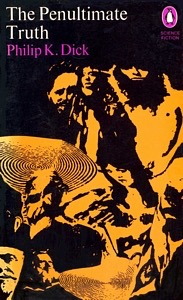

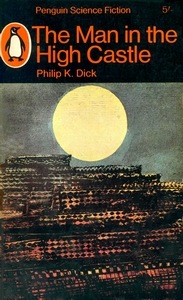
Reading The Penultimate Truth I had that feeling you get when discovering a new author, that you are being led into a strange new world, not quite like anything else. It is hard to say why. It is not the best of PKD’s books, and even at his best he was not a great stylist. But there was something about the worlds Dick made, and the ideas he played with, that made him different from the others. Or maybe it was just the arty covers.
I might not have been so impressed, had I seen some of his US covers first.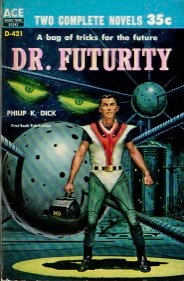
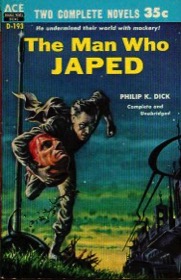

But I read them anyway, and they seemed just as good. For a couple of years I scoured every bookshop, or book exchange (an odd institution that existed at that time, but now seems hard to explain), in the hope of finding imported US editions of the many PKD titles that had not yet been published in the UK. I was quite successful, and still have a few Ace Doubles (two stories printed back to back) and Daw originals.
The covers were garish, the paper was thin, and the print smudged, but somehow that was appropriate. One of Dick’s themes was the thinness of reality, through which other things showed, dimly and indistinctly, hinting at something deeper. The plots, though, hinted at something shallower. Like a lot of other SF writers, PKD began by writing short stories for the pulp magazines. The magazine editors didn’t pay much, and had set ideas about what would sell. But PKD always managed to smuggle a few strange ideas into his stories. As well as space ships, time travel, morphing machines, and argumentative robots, there are fake realities, false memories, artificial animals, hallucinatory drugs, psychic powers, new religions, conspiracies, delusions, madness, alien oracles, human-seeing non-humans, and so many other strange ideas that ending this sentence with “etc” would understate the case.
It was through reading PKD that I discovered philosophy. He liked to quote the pre-Platonic Greeks, like Heraclitus, as well as St Augustine, and various Gnostics. He probably made a lot of it up to suit his purpose, and his wisest words were often spoken by non-humans, androids, simulacra, autonomic household appliances, and aliens, such as Lord Running Clam, the giant Ganymedean slime-mould who appears in Clans of the Alphane Moon.
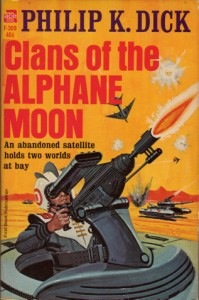
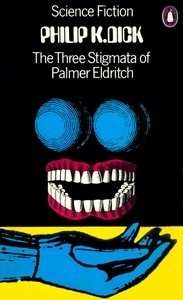
As usual, the cover is misleading. There is little, violence. There is a cast of confused and conflicted characters, some, but not all, mentally ill. There are politicians, comedians, psionics, divorcees and androids. And there is Lord Running Clam, an interplanetary dealer in stamps, diamonds and gold. He (if that is the right pronoun) is also a dispenser of wisdom. Despite his amorphous appearance, telepathic abilities and alien origin, he is the most humane character in the book. Clans of the Alphane Moon is a very strange book, but its strangeness seems accidental, as though PKD, working desperately to produce six books in a year, simply forgot to censor his own innate strangeness.
In the fifties and early sixties, PKD was prolific, writing several novels and short stories every year. 1964 was a typical year. As well as Clans, he wrote Now Wait For Last Year (very good), The Zap Gun (not bad), The Unteleported Man (bizarrely awful), Deus Irae (terrible), and The Three Stigmata of Palmer Eldritch (some call it his masterpiece: I’m not so sure).
In the late 60’s he wrote less, and the quality was highly variable, with hints of what was causing the trouble (drink, drugs, bitter divorce, madness). The Three Stigmata of Palmer Eldritch was a good example, featuring Martian colonists with bad marriages, who take hallucinatory drugs to escape their squalid lives, and who may be rescued by Palmer Eldritch, an altered human with godlike (or demonic) powers, just back from Proxima Centauri, who peddles another drug which might actually change reality rather than merely disguising it. There is also alien-induced global warming, psychic precognition, artificial evolution, drug-induced time travel, and mystical quasi-theology. It was published by Penguin in 1973, just at the time that PKD had slowed right down, and struggled to write anything.
I did not enjoy his later SF works. It was embarrassing to see a middle-aged writer ingratiating himself to his hippy friends by quoting rock lyrics and Lord of The Rings, and taking even more drugs. And he got religion, too. Not the hippy New Age kind, but some sort of Episcopalian / Gnostic mix, all of his own devising. Or maybe that is New Age. Whatever it was, I found it indigestible and unwelcome. I stopped reading his books, and stopped reading science fiction in general. The thirty or so titles I had collected (a few had mysteriously disappeared, returning, perhaps to the alternative reality they came from) were relegated to a seldom-seen shelf and forgotten.
But then, in the 80’s, new and unexpected PKD titles began to appear. In the few years since I had hidden my paperback hoard, PKD had become a cult. In 1982, just after he died, Blade Runner, the film version of Do Androids Dream of Electric Sheep, came out. Other films followed. Eager fans wanted to read everything he wrote. His posthumous novel The Transmigration Of Timothy Archer (about a Californian bishop whose quest for enlightenment leads to death in the Negev Desert) was followed by The Man Whose Teeth Were All exactly Alike, In Milton Lumkey Territory, Confessions Of A Crap Artist, and a handful of others. They were not science fiction, but mainstream novels, written in the 50’s and 60’s and rejected by his publishers. While he was churning out short stories for the pulps, he was also trying to write the Great American Novel, and failing. The mainstream stories were not masterpieces. It is easy to see why they were rejected during his lifetime. But, taken all together, they amount to a sort of surreal fictional autobiography, and serve as a key to his science fiction, much as Empire of the Sun is a key to JG Ballard’s earlier work.
Unfortunately, PKD’s late success led to the publication of other, odder books. The VALIS trilogy was written after a psychotic episode in 1976, in an attempt to explain the mystical revelations that had been beamed into his mind by a vastly superior intelligence. These last books do not enhance his reputation. In the end, I am not sure what to make of him. He wrote a few great novels, some really bad ones, and many others that were somewhere in between. Most of them are interesting. Maybe he did write the Great American Novel, but scattered its fragments throughout all his other books, revealing his wisdom through concealment, like the Gnostic he aspired to be.
Some Philip K Dick websites
http://www.philipkdick.com/
http://en.wikipedia.org/wiki/Philip_K._Dick
http://www.philipkdickfans.com/
http://www.pkdickbooks.com/
http://downlode.org/Etext/pkdicktionary.html